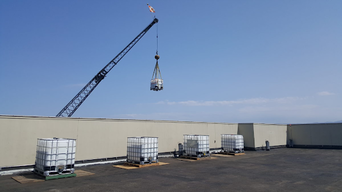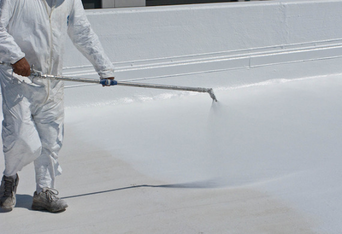Determining a Roof Repair System Ideal for Healthcare Facilities

By Western Colloid.
Healthcare workers, patients and residents need functional and safe buildings now more than ever.
For many reasons, the healthcare industry has received a spotlight of attention from news and media outlets due to the advent of COVID-19. While it’s imperative that healthcare workers on the frontline receive the support and necessary supplies they need, the buildings they work within must also be fully functional. It is the responsibility of hospitals and assisted living administrators to ensure the facilities are safe and in good repair for their workers, but also for their patients and long-term residents.
Renovations and repairs in any building are disruptive. Areas of the building get closed off, causing additional traffic in other places as workers come through. Occupants are disturbed as repair work creates noise, debris and odors.
These issues are of even greater concern in healthcare facilities, which operate twenty-four hours a day and where patients are at greater risk than the normal population. Facility management teams looking to undertake projects need solutions like roof repair systems that will require only minimal disruption and not put patients or staff at unnecessary risk.

Factors for choosing a hospital and assisted living roof repair system
While any facility operator wants a new roof system to offer features like longevity, durability and improved energy efficiency, hospitals have additional specific criteria that need to be filled. These include:
-
Very low-odor and low-VOC solutions
-
Fast installation
-
No disruption to building access or residents
-
Compatibility with existing roof systems
When talking about air quality standards, hospital patients and elderly residents in assisted living facilities are referred to as “sensitive receptors.” With immunocompromised patients, extra care must be taken to not expose them to chemical components in roofing materials, particularly for those people with respiratory issues.
Choosing a roof repair system with a low-VOC formulation helps reduce the risk to sensitive receptors, and choosing a low-odor product, even where no exposure hazards exists, will help maintain everyone’s peace of mind.
Hospitals and long-term care facilities are also looking for commercial roof coatings that can be installed quickly. Smaller healthcare facilities may not have dedicated property managers to oversee work at a single site and make sure contractors are on-site as expected over the course of a long project. They need easy installations and reliable contractors.
Part of managing project timelines is selecting a roof repair system that is compatible with existing materials. More than other commercial buildings, hospitals and assisted living facilities need to be especially proactive in their roof repair and maintenance programs in order to protect the people inside, but this means that issues need to be addressed before a full tear-off and replace program is required.
By selecting a roof coating system for hospital roof repair that is compatible with the existing roof system, whether it is BUR, single ply, TPO or metal, contractors can get on site quickly and get the work done with limited disruptions.
And speaking of disruptions, one of the key elements of roof repair for healthcare facilities is making sure there are limited disruptions in and around the building throughout the project. Roof access may be limited, and most hospitals won’t want contractors walking through operational and patient areas with tools and materials.
And while it’s not uncommon for an office building to block off areas of a parking lot to store equipment — or to limit construction hours to evenings and weekends if managing tenant complaints is a concern — roadways and parking lots at healthcare facilities, particularly hospitals, need to be accessible 24/7 in case of emergencies.

Why roof coatings are the best roof repair system for hospitals and assisted living
For facility administrators looking for the best solution for their hospital or assisted living facility, a Fluid Applied Reinforced Roof (FARR) system checks all the boxes. Coatings like asphalt emulsion and acrylic layered with polyester fabric for strength, are designed specifically to conform to your building. The result is a fully adhered, durable, long-lasting waterproof system that comes with a 10- to 20-year warranty.
Roof coatings are well suited to all kinds of climates, from hot desert sun to heavy snow. Their design includes layers of redundancy, which helps keep water out, even in the event of extreme weather like hail, while requiring very limited maintenance to keep it in good repair.
These coatings also come with environmentally-friendly, low-VOC formulations, which means they can be safely applied at fully operational hospitals and assisted living facilities without putting patients at risk or creating nuisance complaints.
And because roof coatings are compatible with a number of existing roof systems, including BUR, Modified Bitumen, Single Ply, Metal Roofing, Sprayed Polyurethane Foam and gravel roofs, they can be applied quickly even around roof-top appliances, exhausts and solar panels, leaving you with a seamless monolithic roof.
Roof coatings can be packaged in pails, drums or bulk totes, according to your facility’s needs. There is no torching, nailing or fastening involved in the installation which limits the amount of nuisance noise associated with other pre-fabricated membrane installations.
The coating materials can be loaded on the roof to limit parking lot congestion and foot traffic in your facility. We’ve even seen Western Colloid roof coatings lifted to the roof via a crane, which is then taken off-site until the totes need to be carried down.
We believe that roof coatings are the right answer for your roofs on hospitals and assisted living facilities. To find out more about roof coating systems, and how to use them for a quick roof repair project and as a durable long term solution, contact Western Colloid to request a free consultation.
Learn more about Western Colloid in their RCS Directory.
Original article source: Western Colloid























Comments
Leave a Reply
Have an account? Login to leave a comment!
Sign In